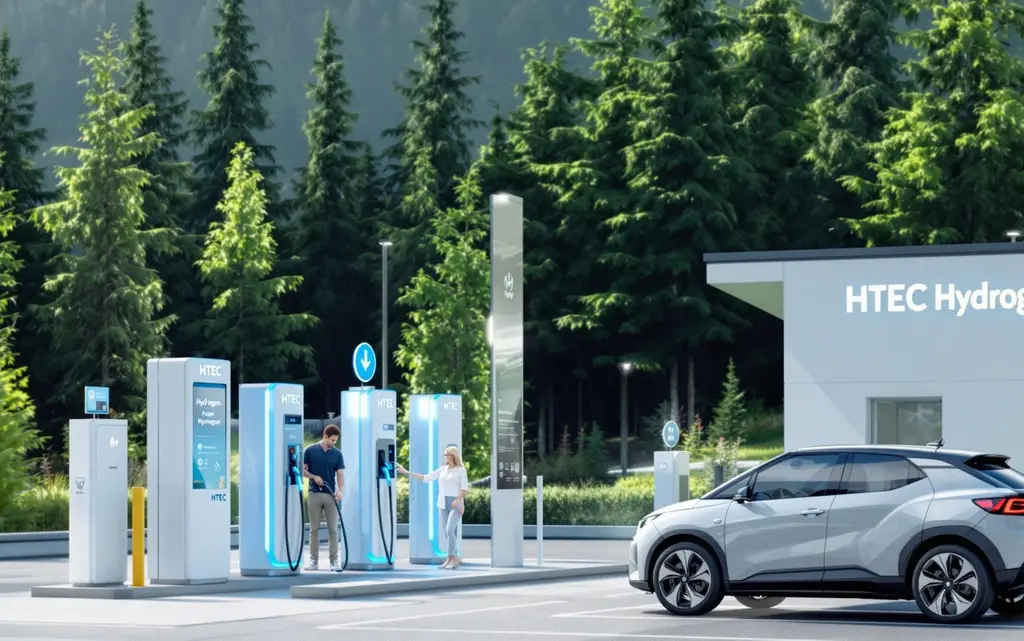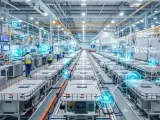
HTEC and British Columbia’s Hydrogen Gamble: Green Hydrogen Fuel, High Stakes, and the Road to Zero-Emission Transport
April 7, 2025British Columbia — known for its lush rainforests, dramatic coastlines, and snow-capped peaks — is now staking a claim in something far from scenic: hydrogen fueling stations. The provincial government has teamed up with HTEC (short for Hydrogen Technology & Energy Corporation), a local company betting big on hydrogen to power the clean transport of tomorrow.
While the move positions B.C. as a leader in clean energy, it hasn’t come without raised eyebrows. On one side, there’s a global surge in green fuel tech, racing ahead regardless of past political resistance like the Trump-era fossil fuel fixation. On the flip side, some are wondering if the province is burning taxpayer dollars on a future that’s not quite here yet — with usage rates at hydrogen stations still pretty low.
Who’s Stepping Up, and What’s at Stake?
HTEC, based in Canada, is laser-focused on building the backbone for hydrogen fuel cell vehicles. They’re laying down the infrastructure — the stations — to make fueling up with hydrogen as easy as topping off with gas. The goal? Enable the switch from dirty diesel and gas-powered trucks and cars to zero-emission, hydrogen-powered vehicles.
The provincial government is all in — backing HTEC with major policy support and public funding. This aligns with B.C.’s CleanBC roadmap, which is all about cutting emissions and building a sustainable economy.
Some of the key technologies supporting this push include:
- Green Hydrogen Production – Made through electrolysis, which uses electricity (from hydro, wind, or solar) to split water into hydrogen and oxygen — zero emissions stuff.
- Hydrogen Fuel Cells – Devices that mix hydrogen with oxygen to create electricity, with water as the only byproduct.
- Hydrogen Fueling Stations – High-tech setups that store hydrogen and deliver fast refueling similar to what we’re used to with traditional fuel.
Sounds great in theory, right? But here’s the rub — some of these fueling stations are barely getting any traffic. And critics are asking the tough question: Is this a smart investment or just optimism on overdrive?
The Bigger Picture: From Oil to Opportunity
Hydrogen isn’t the new kid on the block. It’s been around since the oil crisis of the 1970s, when folks first realized it might be smart to have alternatives to fossil fuels. But it’s only in recent years — thanks to the urgency of the climate crisis and cheaper renewables — that clean hydrogen has gained serious momentum.
Across the globe — from Europe to Japan to Australia — governments and companies are pouring billions into hydrogen. Automakers like Toyota have gone all-in on models like the MIRAI, a sedan powered entirely by fuel cell technology.
Back in the U.S., hydrogen didn’t get much love during the Trump years, when the spotlight stayed firmly on oil and gas. But Canadian outfits like HTEC kept moving forward, betting that hydrogen’s time was still coming. Now, the future they’ve been building for might finally be arriving.
B.C.’s Bold Move: Risky or Just Ahead of Its Time?
Here’s the core tension in B.C.: They’ve built the platform, but the audience hasn’t quite shown up yet. The government’s put up funding, HTEC’s built the stations, but not enough vehicles are using them. It’s like putting Bluetooth speakers in the forest — impressive tech, but who’s there to press play?
Still, if you ask HTEC or government leaders, that’s the whole point. They’re thinking ahead. Once manufacturers ramp up hydrogen vehicle production and more fleets start switching over — commercial delivery vans, city buses, or long-haul trucks — they want to make sure the infrastructure is already in place. You can’t ask folks to drive hydrogen-powered cars if there’s nowhere to fill them up.
The Real Challenge: Who Blinks First?
This is the classic chicken-and-egg dilemma. Do you build the stations first and hope the cars follow? Or wait for more vehicles, risking no one bothers to adopt because there’s no place to refuel?
This isn’t just a B.C. issue. Germany’s H2 Mobility is building out a national hydrogen network while supporting public transit fleets. Over in Japan, the ENE-FARM initiative makes in-home hydrogen energy a reality. Everyone’s trying to crack the same code — and most agree that someone has to make the first move.
Being first often means taking the punches. But it’s also how you open doors for the rest.
What’s at Stake Down the Road
If this gamble pays off, B.C. might wind up as North America’s hydrogen hub — a shining example of how to turn a pioneering policy into real-world results. Think local economic growth, emission cuts, green tech exports — the kind of future that hits both the climate and economic sweet spots.
For HTEC, nailing this rollout could put them leaps ahead in the hydrogen infrastructure race — not just in Canada but possibly in U.S. states or even overseas markets that are eyeing similar strategies. But their success really depends on momentum: fleet contracts, public transit conversions, maybe even hydrogen ferries serving the B.C. coast one day.
Until then, don’t expect the critics to go quiet. There’s valid concern about cost, usage, and whether public dollars are being stretched too thin, too soon. Still, in the long view — especially with global zero-emission targets for 2030 and 2050 out there — this might be the kind of early play that ends up aging really well.
What’s Standing in the Way?
Let’s be real — hydrogen isn’t a slam dunk yet. It’s still pricey to produce, especially green hydrogen. Car availability is limited, and a lot of folks don’t trust or even know enough about hydrogen tech. Safety is often mentioned, though most modern fueling stations meet very strict standards.
Then there’s the conversation about blue hydrogen — which uses natural gas plus carbon capture. Some see it as a necessary bridge. Others call it greenwashing. The debate rages on.
What Has to Happen Next
For hydrogen to move from “let’s wait and see” to “get me one of those,” a few stars need to align:
- More vehicles — everything from cars and buses to delivery trucks — need to hit the roads.
- Public awareness — people need to understand that hydrogen is safe, clean, and available.
- Technology that gets cheaper — particularly fuel cells and electrolyzers — with help from mass production and innovation.
- Policy consistency — future governments need to stay the course and not undo years of planning.
If all that comes together, green hydrogen could finally live up to its hype as a major player in the move to sustainable transportation.
Final Thought
It’s a bold vision. No doubt about that. British Columbia and HTEC are taking a gamble unlike most. But here’s the thing — every big shift starts with someone going first. If they’re right, this move could put B.C. years ahead in the race for clean transportation. If not, it’ll be a hard lesson in moving too fast, too soon. Either way, they’re shaping the future — and that’s something to watch.
About HTEC
HTEC (Hydrogen Technology & Energy Corporation) is a Canadian clean energy company focused on building the critical hydrogen infrastructure needed for zero-emission transport. From producing hydrogen to distributing it to operating retail fueling stations, HTEC is laying the groundwork for a future where mobility doesn’t cost the planet.



 With over 15 years of reporting hydrogen news, we are your premier source for the latest updates and insights in hydrogen and renewable energy.
With over 15 years of reporting hydrogen news, we are your premier source for the latest updates and insights in hydrogen and renewable energy.
Nothing here about cost of fuel and vehicles. When I drove an EV my costs were far lower than gasoline since I charged at home. That apparently hasn’t been enough to get most people to switch. If hydrogen costs more than gasoline, the rollout is going to be even slower.
Not one reference to the companies, right now, that are trying to bring in White/Gold Hydrogen, in Canada. We are on the cusp of bringing Hydrogen drillings and the cheap underground Hydrogen to market. Perhaps that is why the B.C. government is bringing out filling stations.
Gold/White Hydrogen is the answer for cheap Hydrogen . Some wells will market it at about $1.00 per liter. That alone will explode the Hydrogen power market worldwide
BC has hydro,wind & solar but no Texas. As it’s cold there, bulk cryostorage becomes a more attractive option. If you have a source of Hydrogen,modern hydrocarbon chemistry allows you to create any hydrocarbon you need. Embargoes and tariffs lose their sting.
Do you think SIDS -Small Islands Developing States – should sjift their energy plicy and produce green hydrogen from floating wind mill farms? I have the feeling that this is the safest road for SIDS to combat carbon emissions and promote their tourism industry. What can companies like HTEC on the one hand and the Government of Canada do to assist these islands. Many islands -Barbados, Mauritius, Seychelles -are toying with the idea of shifting to a Hydrogen economy. What are the cost implications and expected high tech job creations? Any idea or comments would oblige.